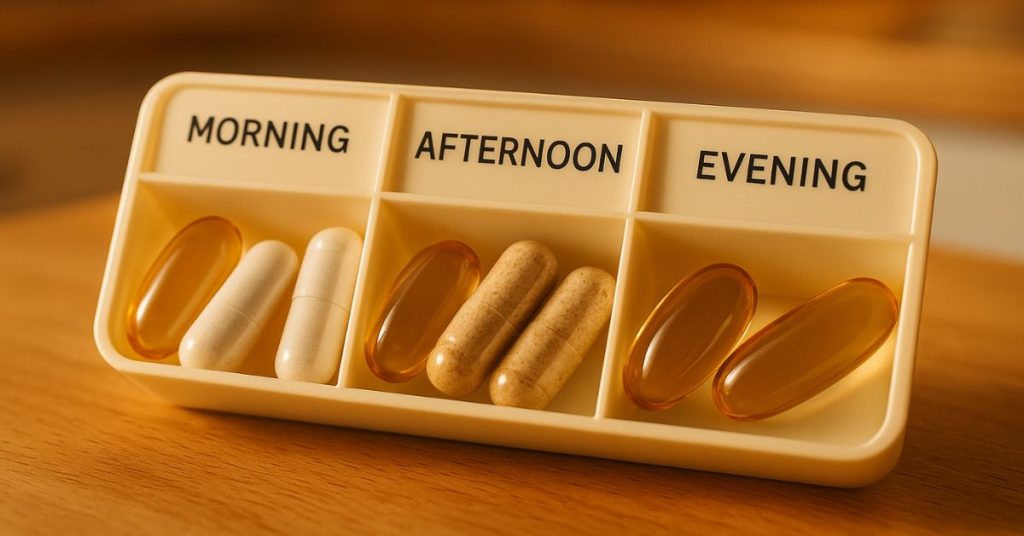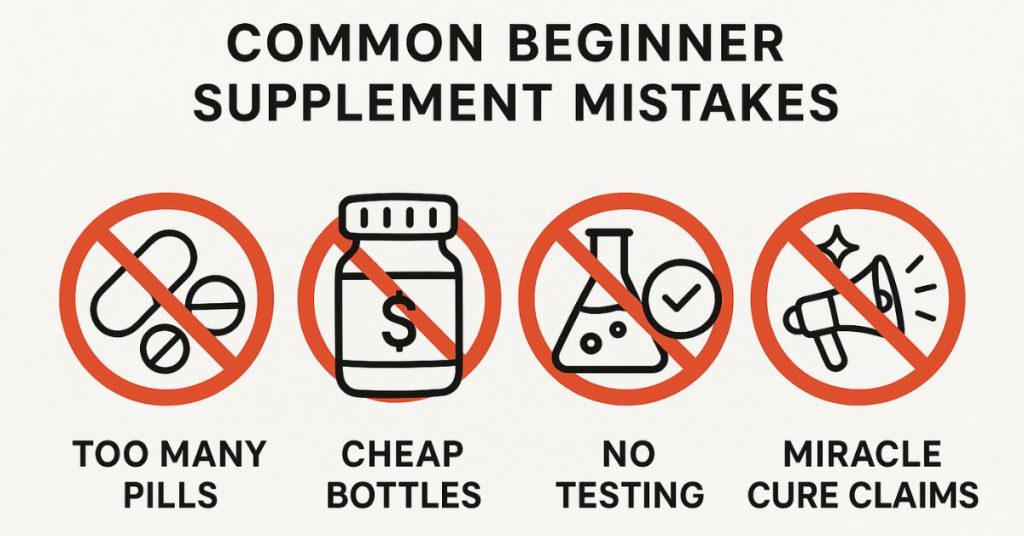Stop Guessing. Start Supplementing—The Right Way.
You walk into a supplement aisle (or scroll through Amazon) and it’s like staring into a rainbow-colored tornado of bottles, promises, and confusing labels. Half the people you know swear supplements are life-changing. The other half call them a scam. The truth? Both sides are wrong—and right.
Supplements can transform your health… if you know where to start.
This beginner’s blueprint will give you the basics, the brands worth your money, the traps to avoid—and how to build a starter stack that actually works—so you’re not paying for overpriced pee.
This post may contain affiliate links. If you click and buy, I may earn a small commission at no cost to you. I only recommend products I use, trust, or have thoroughly researched.
Step 1: Know Your Goals (and Gaps)
Before you start clicking “Add to Cart,” figure out why you’re taking supplements:
- Fill nutrient gaps – Maybe your diet’s short on vitamin D, magnesium, or omega-3s.
- Support a specific goal – More energy, better workouts, stronger immunity.
- Manage a condition – Blood pressure, joint health, brain support.
💡 Pro Tip: Get a basic blood test or talk to your doctor. Starting blind is how people waste money or take stuff they don’t need.
Step 2: Build a Starter Stack
Keep it simple at first—three to five essentials max. These are proven, beginner-friendly, and have strong research backing them.
1. A Quality Multivitamin
Think of this as your nutritional safety net. Look for high-potency forms like methylated B-vitamins and chelated minerals.
- Example: Life Extension Two-Per-Day – Highly rated, USP-verified, broad nutrient coverage.
Why it matters: Even a healthy diet can miss key nutrients. A multivitamin closes those gaps without overloading you.
2. Vitamin D3 + K2
Most people are deficient in D3, especially if you live in northern climates or work indoors. K2 helps direct calcium to your bones and teeth instead of your arteries.
- Example: Sports Research D3 + K2 Softgels – Non-GMO, coconut oil base for better absorption.
Why it matters: D3 supports immunity, mood, and bone strength; K2 works alongside it to protect your heart.
3. Omega-3 Fish Oil
Supports heart, brain, and joint health. Choose triglyceride-form for better absorption and always check for third-party purity testing.
- Example: Viva Naturals Omega-3 Fish Oil – Triple strength, IFOS-certified.
Why it matters: Omega-3s help reduce inflammation, improve cognitive function, and support cardiovascular health.
4. Magnesium (Glycinate or Citrate)
Good for muscles, nerves, sleep, and energy production. Avoid cheap oxide forms—they absorb poorly and can cause stomach upset.
- Example: Doctor’s Best High Absorption Magnesium – Chelated for maximum bioavailability.
Why it matters: Magnesium is involved in 300+ body processes, from heart rhythm to stress management.
5. Protein Powder (Optional)
If you’re not hitting your protein target through food, this fills the gap—without cooking another chicken breast.
- Example: Optimum Nutrition Gold Standard Whey – Trusted, third-party tested, mixes easily.
Why it matters: Adequate protein supports muscle maintenance, recovery, and healthy metabolism.

Step 3: Introduce Supplements Gradually
Don’t start everything at once. Add one product, take it consistently for a week or two, and see how you feel. This helps you spot what’s working and avoids side effect guessing games.
Step 4: Timing & Consistency Matter
- Morning: Multivitamin + D3/K2 (with breakfast for fat absorption)
- Afternoon: Fish oil (with food to prevent “fish burps”)
- Evening: Magnesium (can promote better sleep)
- Protein powder: Anytime you’re low on protein intake or post-workout
💡 Consistency beats timing—take your supplements daily to get results.
Step 5: Buy Smart & Avoid Scams
- Look for third-party testing seals: USP, NSF, ConsumerLab.
- Avoid “proprietary blends” that hide exact dosages.
- Stick with brands that disclose sourcing and manufacturing standards.
- Read actual customer reviews, not just the top ones—look for long-term users reporting results.
Skip These Beginner Mistakes
Even the best supplements won’t help if you’re making rookie errors. Avoid these from day one:
- Starting 10 new supplements at once – You’ll never know what’s working (or what’s causing side effects).
- Buying the cheapest thing on Amazon – If it’s $5 for a “premium” 200-count fish oil, it’s probably low quality or rancid.
- Ignoring dosage and form – Magnesium oxide? Almost useless. Vitamin D without K2? Less effective. Always check the label.
- Taking fat-soluble vitamins on an empty stomach – Vitamins A, D, E, and K need fat to absorb—take with a meal.
- Skipping third-party testing – No USP, NSF, or ConsumerLab seal? You’re trusting marketing instead of science.
- Falling for “miracle cure” claims – If it says it can cure everything from joint pain to hair loss to “low vibes,” run.
- Never re-evaluating your stack – Your needs change—what you start with now might be overkill in six months.

Side Effects & Interactions: What to Watch For
Even safe, well-researched supplements can cause issues if you overdo it or mix them with the wrong meds. Always check with your doctor before starting.
Multivitamin
- Possible issues: Nausea if taken on an empty stomach; some formulas too high in iron for men/post-menopausal women.
- Interactions: High-dose vitamin K can interfere with blood thinners like warfarin.
Vitamin D3 + K2
- Possible issues: Too much D3 can raise calcium levels—leading to kidney stones or heart strain.
- Interactions: Can interfere with certain diuretics and heart medications.
Omega-3 Fish Oil
- Possible issues: Mild stomach upset or “fish burps.” High doses may thin blood.
- Interactions: Can increase bleeding risk if you’re on aspirin, warfarin, or other anticoagulants.
Magnesium (Glycinate/Citrate)
- Possible issues: Loose stools with high doses of citrate form.
- Interactions: May reduce absorption of certain antibiotics if taken together—separate by at least 2 hours.
Protein Powder
- Possible issues: Bloating, gas, or digestive upset (especially with lactose intolerance).
- Interactions: Generally minimal, but check ingredients for additives or artificial sweeteners you may be sensitive to.
💡 Rule of Thumb: Start with the lowest effective dose, monitor how you feel, and review with your healthcare provider every few months.
Step 6: Reassess Every Few Months
Your needs will change. Update your stack as your diet, goals, or health shifts. Sometimes less is more—don’t take something forever just because you started once.
The Bottom Line
Supplements aren’t magic pills, but they can be powerful tools when used wisely. Start small, stick with quality brands, and let your results—not marketing hype—guide your choices.
If you’re ready to start, begin with the essentials—then build from there. Small, consistent steps will beat big, inconsistent ones every time.